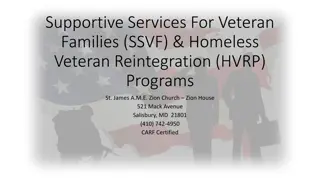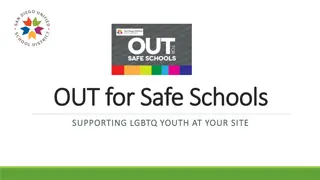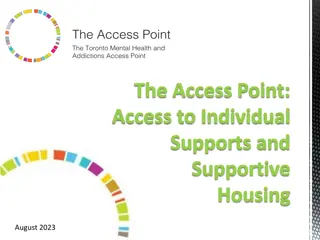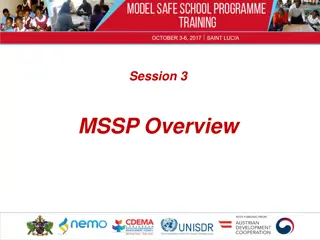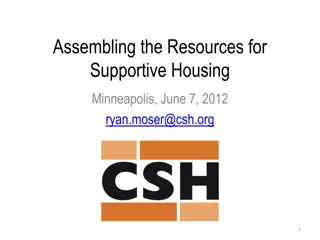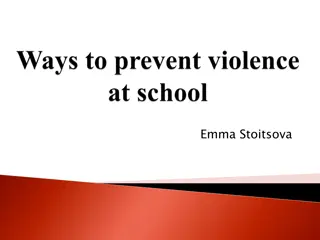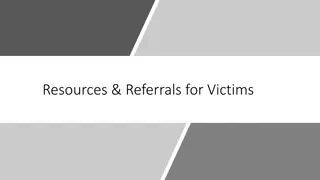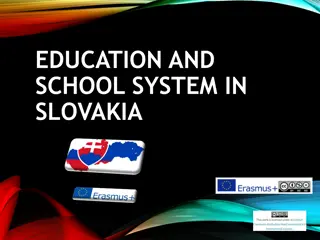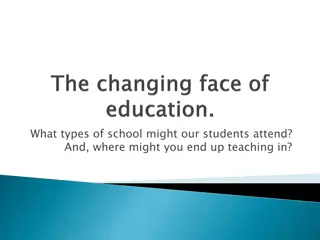Enhancing Access to Resources for Safe & Supportive Schools: A Comprehensive Overview
Explore the Safe & Supportive Schools Commission Retreat's focus on mapping access to resources for school environments that foster wellbeing. Delve into data collection, behavioral health capacity in schools, SaSS framework elements, and the importance of defined access to services and resources.
Download Presentation

Please find below an Image/Link to download the presentation.
The content on the website is provided AS IS for your information and personal use only. It may not be sold, licensed, or shared on other websites without obtaining consent from the author. Download presentation by click this link. If you encounter any issues during the download, it is possible that the publisher has removed the file from their server.
E N D
Presentation Transcript
Safe & Supportive Schools Commission Retreat Mapping Access toResources 7.24.19 (updated9.6.19) Melissa M. Pearrow, Ph.D., Sara Whitcomb, Ph.D.,& Whitney Walker,M.S. BIRCh Project, UMass Boston & UMassAmherst
Objectives of Safe & Supportive Schools (SaSS) Retreat Presentation Background of Mapping Project Data collection procedures Findings and Limitations Q & A 2 2
Schools Capacity to Address Behavioral HealthNeeds Rosie D vs Commonwealth (2007) led to Children s Initiative Initiative Children s Behavioral Behavioral Health Health Strengthen capacity Returned many children with intensive needs to the community Lacked concomitant supports for school professionals (though it did create Behavioral Health Task Force) capacityof community-based behavioral health services Interviews Interviewswith School Mental Health Consortium (April, 2019) Overwhelming need and long waitlists Workforceshortfalls Insurance barriers 3
Safe and Supportive Schools(SaSS) Framework Six elements of the Framework Leadership, infrastructure and culture Professional learning opportunities Access to resources and services Teaching and learning that fosters SaSS environments Policies, procedures, and protocols Family engagement 4
Safe and Supportive SchoolsFramework Six elements of the Framework Leadership, infrastructure and culture Professional learning opportunities Access to resources and services Teaching and learning that fosters SaSS environments Policies, procedures, and protocols Family engagement 5
Access to Services andResources Defined as identification, identification, coordination, and community behavioral health services that improve the school school- -wide wideenvironment. environment. coordination, and creation creationof school Recognizes the need for resources that are clinically, and culturally culturally appropriate appropriate for students and their families. clinically, linguistically linguistically Schools indicated the greatest resources and create recommendation to address gaps in resources and services. greatest need need was help to map 6
Purpose of the MappingProject What is the current access to school-based professional support personnel for students in Massachusetts? How does student economic need influence this access? Which districts have the greatest need for more accessible school-based professional support personnel? 7
Data Collected andAnalyzed Publicly accessible data through DESE 406 Districts 291 Local and regional school districts(LEAs) 84 CharterSchools 29 Vocational/TechnicalSchools 2 Onlineschools School Demographics Number of students Percentage of economically disadvantaged students Number of professional support personnel staff 8
Data Collected andAnalyzed (Continued) DESE Licenses for Professional Support Personnel (PSP) with 60+ graduate hours and supervised field experience School Counselor (Levels: PreK-8;5-12) School Social Worker/School Adjustment Counselor(All) School Psychologist (All) School Nurse(All) Data NOT included Other categories of support personnel (rehab counselors, diagnostician) Educational collaboratives (ACCEPT,CASE) More restrictive placements (ART, Inpatient, DYS) Community-agency behavioral health providers (Riverside,SSMHC) 9 Schools with less than 5 students
OverallFindings 7,475 PSP in schools to meet the needs of 951,631 students 5,427 school-based behavioral health staff (SAC/SSW, GC, & SP) ProfessionalSupport PersonnelLicense Numberof Professionalsin MASchools 1,777 Ratioof Staff:Student National Recommended Ratios 1:250 School SocialWorker/ School AdjustmentCounselor (SSW/SAC) School Counselor 1:536 2,353 1:404 1:250 SchoolPsychologist 1,297 1:734 1:500 School Nurse 2,048 1:465 1:750 10
Code and Categorize forComparisons Code and categorize into quartiles based on: Percentage of economically disadvantaged students (1-4) Ratios of professional support personnel (1-4) Ratios calculated for type of district with greatest need 9.3% (37 districts) rated the highest in BOTH economically disadvantaged students AND highest PSP ratios (8) 7% (29 districts) very high level of need (7) 53% of these very high need districts (7) are charter school In total, 35 of the 84 charter schools were coded as very high needs * = Districts with 2019 Safe and Supportive Schools Grant 11
Access to school behavioral health by economicneed Recommended Lowest Mid-low Mid-High Highest SSW/SAC 1:250 1:693 1:588 1:437 1:478 SchoolCnslr 1:250 1:358 1:404 1:380 1:458 SchoolPsych 1:500 1:540 1:661 1:738 1:1,065 SchoolNurse 1:750 1:486 1:441 1:473 1:441 12
LEAs (districts) with greatest need and fewest professionals (8) Highest Quartile of Economic Disadvantage Boston 57% Brockton 54% Chelsea* 63% Everett 48% Lynn 57% Revere 47% Worcester 58%
School Districts identified with Very High Need(7) Attleboro Lawrence Rowe Worthington FallRiver* Lowell SouthHadley AyerShirley Regional Monomoy Regional* Narragansett Regional Florida Malden Springfield* Haverhill NorthAdams* Sunderland Holyoke Orange Ware 14
What do These FindingsMean? Local and regional districts are staffed to support the behavioral health needs of students. There is great variability in access to behavioral health supports based on students economic need. Our most vulnerable students who are educated in charter schools may have less access to school-based behavioral health supports. Does not capture the unique needs in Western Massachusetts. 15
Limitations Findings are only as good as the data collected. Findings do not indicate how these behavioral health resources are utilized by districts (e.g., elementary vs secondary). Analysis does not include partnerships with community agencies; however, there are limits to the professional responsibilities of these partners. Professional recommended ratios present challenges. 16
Next Steps for BIRChProject Behavioral Behavioral health Project) The mission of the BIRCh Project is to provide professional development and resources for schools and strengthen the coordination of behavioral health supports provided by school and community agencies. Collaboration between UMB andUMA Funded by Boston Children s Hospital Target resources and support to high need districts/LEAs Offering training next spring health Integrated Integrated Resources Resources for for Children Project Children Project(BIRCh 17
THANKYOU Melissa Pearrow, Ph.D. & Sara Whitcomb, Ph.D. Whitney Walker, M.S., Doctoral Student Birch.project@umb.edu BIRCh email: Birch.project@umb.edu www.umb.edu/birch BIRCh website: www.umb.edu/birch




